Text and images copyright Kristian Andrews 2024
Welcome to the second part of this series on learning film photography. If you missed the first part you can find it here. This entry is all about helping you to choose the best type of 35mm film camera for you.
The topics covered in this series include:
- What is Film Photography?
- Types of 35mm film
- Types of film cameras
- How to load film
- Shooting with film
- Developing and scanning film
In this post you will find an introduction to the common types of 35mm film camera, including compact cameras, rangefinders, and SLRs.
Introduction
At their heart all film cameras are more or less the same, they all have the following parts:
- A lens to focus the image
- A shutter to control how much light reaches the film
- A light tight box to hold for the film
Of course there are as many variations on these as there are film cameras. Some of the key differences you will find between cameras are:
- Fixed, zoom or interchangeable lenses – Some cameras have a fixed lens, while on others you can zoom in and out, or remove the lens and change it for a different one to get a wider or narrower view.
- Light meters – A light meter is used to work out how long the shutter should stay open to get the correct amount of light onto the film. Some cameras have no light meter at all, some have simple meters, and others have advanced computerised light meters.
- Shutters – Basic cameras might have a fixed shutter, meaning it only opens for the same amount of time for each frame, while other cameras have a variable shutter that might allow exposures from 30 seconds to 1/4000 of a second in advanced models.
- Viewfinders – When taking a photo you need a way to compose your scene. Some cameras have a separate viewfinder while others allow you to look through the same lens that will be used to take the photo.
- Auto winders – On a lot of older film cameras you have to manually wind on the film after each shot, and wind it back into the canister when the film is all used. On more automated cameras the film will be wound on and rewound by a motor drive.
- Focussing – Some basic cameras have a fixed focus lens, while others can be focussed either manually or with autofocus.
- Exposure control – Many compact and simple camera offer no control over the exposure, while more advanced cameras may give you partial or full control over how bright or dark the image is.
- Size and weight – Although they all use the same film there can be big differences in portability between types of cameras. A compact camera can be small and light enough to fit in a pocket while an SLR can be big and heavy, typically needing to be carried on a neck or shoulder strap.
Below we will look at show several different types of 35mm film cameras using examples from my collection. We will look all the above points for each camera to give you an idea of the benefits for each type.
Point and Shoot
A Point and Shoot camera is just that, a camera you don’t need to think about, you just point it at what you want to take a photo of and press the shutter button. Point and Shoots range from the very basic to advanced, but the thing they have in common is that you don’t need to know much about photography to use one.
Point and shoot cameras start from the most basic camera setup possible, with fixed exposure, fixed focus and manual winding. The Polaroid branded camera below is an example of exactly this.
Basic Point and Shoot: Polaroid 170 BV
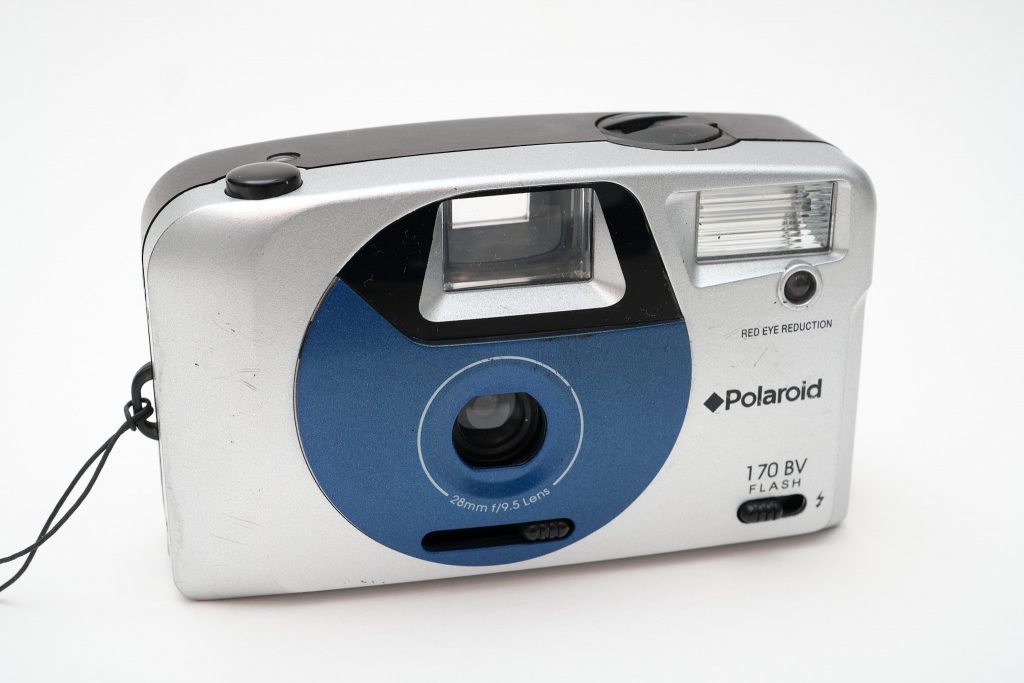
A quick summary of the specs:
- Lens: Fixed 28mm plastic
- Focus: Fixed focus 1.5m to infinity
- Viewfinder: Separate viewfinder
- Exposure: Fixed, no light meter
- Film speed setting: None
- Film winding: Manual
- Size and weight: Compact, lightweight
This camera has no adjustments that can be made, except for turning the flash on and off manually. As the lens focus is fixed the camera can only take clear shots of things more than 1.5m from the camera, so it is not suitable for selfies or any other kind of close up photography. Also, as the lens is made of plastic it will not be the highest quality and so you could not expect the images to be highly detailed. Lastly, there is no light meter and the camera has only one shutter speed and aperture, so the camera cannot adjust if the scene is bright or dark.
There is nothing wrong with this type of camera, you just need to be aware of the limitations it has. If you just want a super simple camera to try out or you like the lo-fi look this camera will give then there are plenty like this on the market to try out.
Advanced Point and Shoot: Nikon AF200
Taking a step up to a more complex compact camera, we have the Nikon AF200:
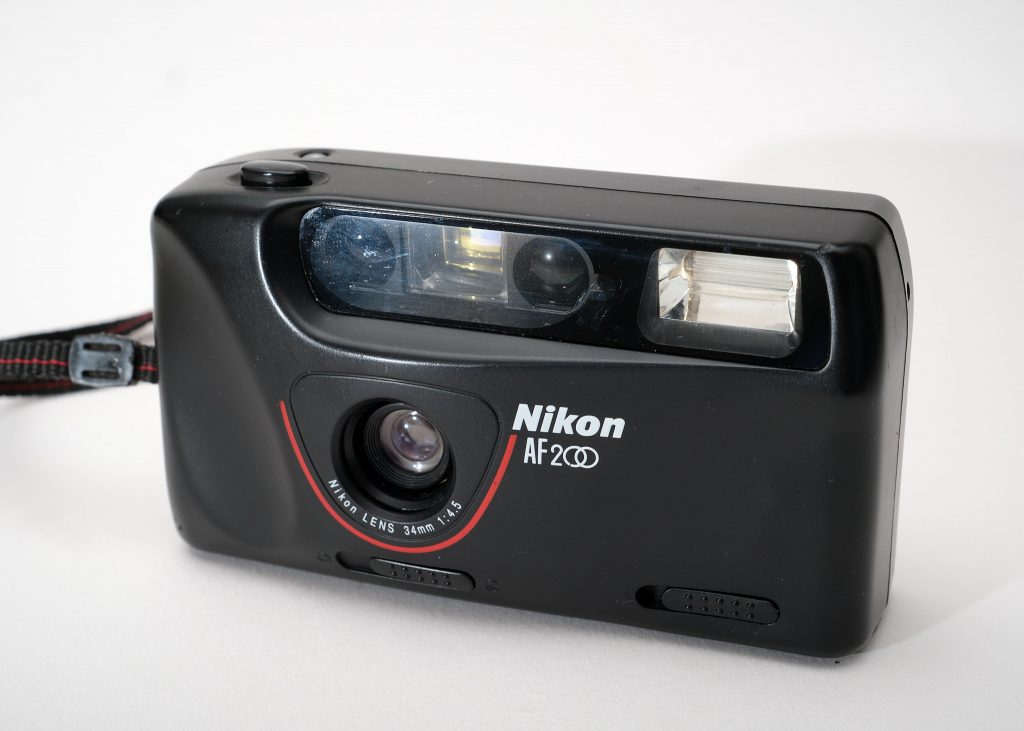
This camera is still a point and shoot but has several improvements over the Polaroid 170BV.
- Lens: 34mm f4 glass lens
- Focus: Autofocus, minimum distance 1.2m
- Viewfinder: Separate viewfinder
- Exposure: Auto exposure with built in light meter (limited shutter speeds)
- Film speed setting: DX coding
- Film winding: Automatic
- Size and weight: compact, lightweight
With these improvements over the Polaroid the camera is a lot more flexible and can be used in a wider range of situations, for example, the camera will detect if you are taking photos in the dark and will turn on the flash for you. With the automatic film winding it is also easier to use, but does rely on batteries to function.
One down side of autofocus point and shoot cameras is that you are never exactly sure what they will focus on. The autofocus can also focus on the wrong thing if you try to shoot through a window or wire fence, in several cases I have ended up with shots like this, for example, a nicely focused wire fence with a blurry tiger behind it.
Overall, the camera is still quite basic, but can certainly get acceptable shots in most situations.
Summary of Point and Shoot Cameras
If you just want a very simple camera that will get reasonable shots on film then a compact point and shoot may be the way to go. You will get very little control over exposure but this will allow you to concentrate on composing your shots well.
As well as the fixed lens cameras included here you will also find many point and shoots with a zoom lens, for example, the Pentax Espio range of cameras. These offer the same simplicity but with the ability to zoom in and out.
In the 80s and 90s most people were using exactly this type of camera, and many people took them to parties, concerts, and holidays; exactly the kind of thing you would use a phone camera for today.
Rangefinder Cameras
Rangefinder cameras are named after the way they are focussed. Rangefinders do not have autofocus, instead you manually focus by aligning 2 parts of an image in the viewfinder. Just like with point and shoot cameras you can find several different types ranging from cheap and simple automatic cameras to expensive cameras used by professionals. The most well known brand of rangefinder is Leica, a German manufacturer of premium cameras that also carry a premium price. Leica has been the favourite brand of street photographers for around 100 years, and so I am sure that many historical photos you have seen will have been shot on a Leica. One of the reasons for this is that often the viewfinder has a wider view than the lens, so when working on shots with critical timing and placement of people you can see what is happening before they get into the frame.
Below I introduce three quite different rangefinder cameras, starting with the Minolta Hi-Matic F.
Automatic Exposure: Minolta Hi-matic F
The Minolta Hi-matic F is a very compact little rangefinder with fully automatic exposure, there is no manual control available beyond the focus. The Hi-matic has a built in light meter and can use a range of shutter speeds from as long as 4 seconds down to 1/724th of a second for bright scenes.
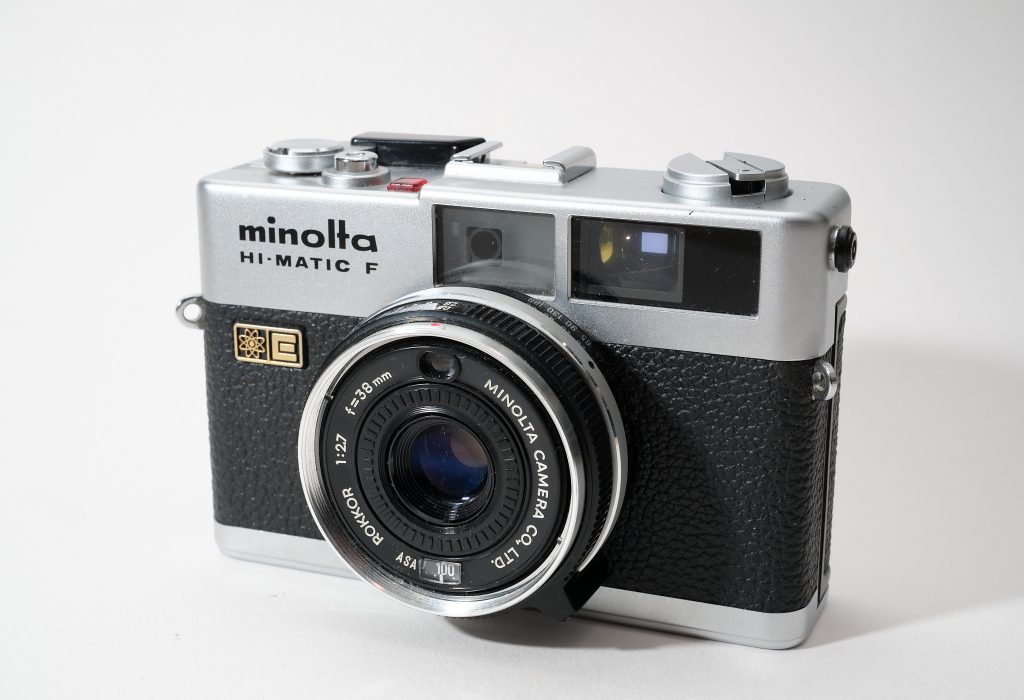
- Lens: fixed 38mm f2.7 glass lens
- Viewfinder: Separate viewfinder with rangefinder patch
- Focus: Manual focus with rangefinder
- Exposure: Auto exposure with built in light meter
- Film speed setting: Manual
- Film winding: Manual
- Size and weight: very compact, medium weight
This camera combines ease of use with a good quality lens, so while it is not as quick to use as an auto focus point and shoot it does ensure that you can focus correctly on your subject. This particular camera was introduced in 1972 and still takes clear and well exposed photos today.
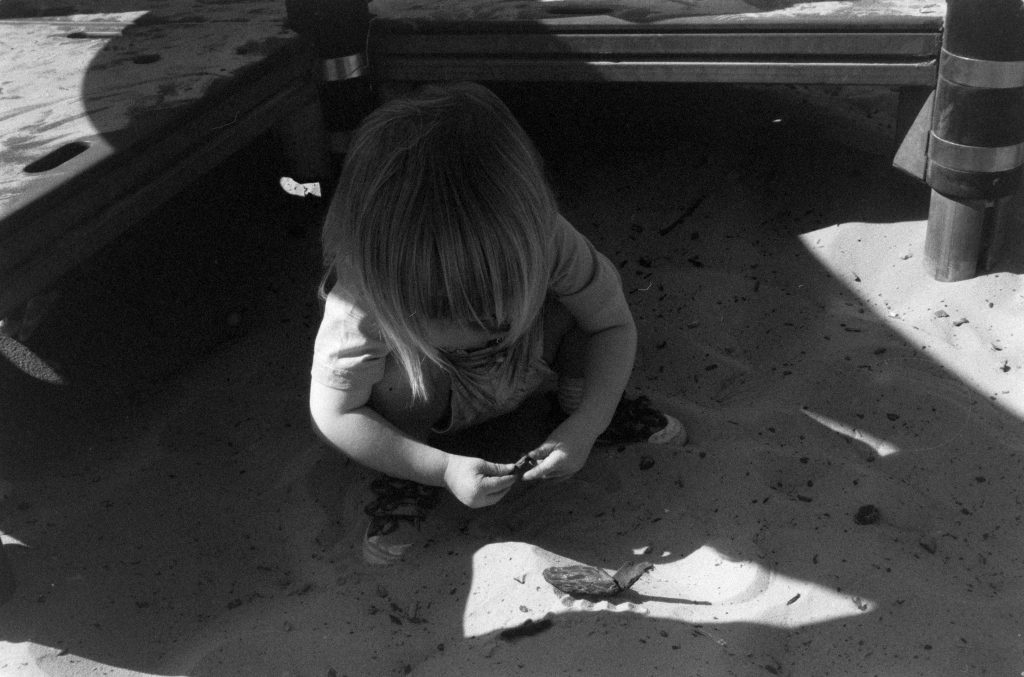
Automatic/Manual Exposure: Olympus 35RC
The Olympus 35RC is very similar to the Minolta Hi-matic F except that it also give you control over the exposure of your images. The 35RC has a built in light meter and can be used in semi-automatic exposure mode where the shutter speed is set manually and the camera chooses the aperture automatically. This gives more creative freedom when taking photos as you might choose a faster shutter speed to freeze action, or a slower one to introduce artistic blur. This method of setting the exposure is called Shutter Priority as you are fixing the shutter speed and letting the camera sort out the rest.
With the 35RC it is also possible to manually select the shutter speed and aperture, but in this case the light meter does not help you to get the correct settings.
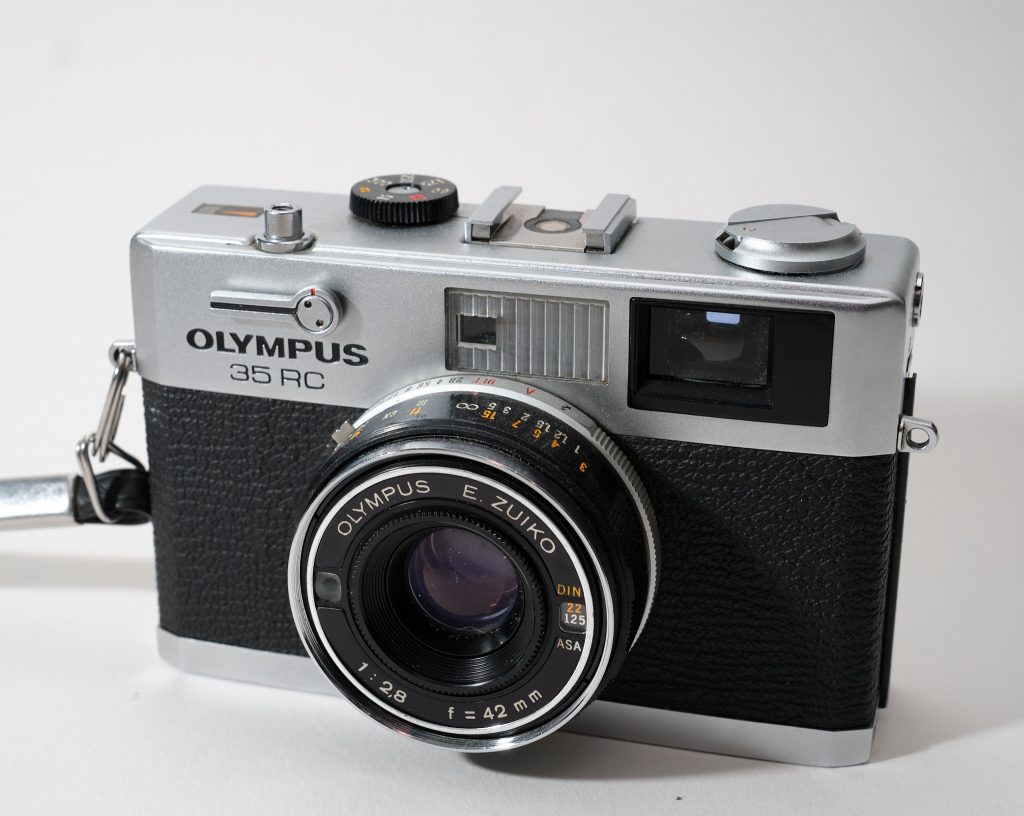
A quick summary of the specs:
- Lens: fixed 42mm f2.8 high quality glass lens
- Focus: Manual with rangefinder
- Viewfinder: Separate viewfinder with rangefinder patch
- Exposure: Shutter priority auto exposure/fully manual
- Film speed setting: manual
- Film winding: manual
- Size and weight: very compact, medium weight
Using the 35RC does require you to make some choices about the exposure, and so to start with it will be a little slower to use than the Hi-matic F or a Point and Shoot, but the added flexibility can more than make up for this by giving you more creative control.
I took one of my favourite shots of the year with this camera while on a seaside holiday.
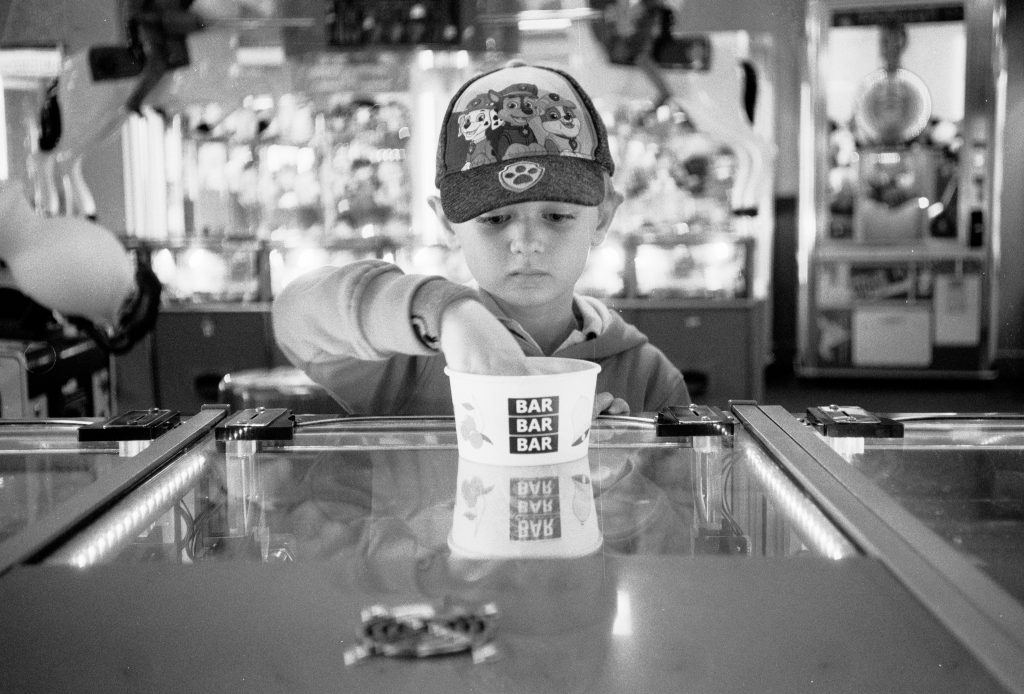
Interchangeable Lens Rangefinder: FED 4
The FED 4 was made in the USSR and differs from all the previously mentioned cameras as it has a removable lens. The FED 4 uses a screw on lens so the lens can be removed and swapped to a different one, giving more options for composing your shots. There is a range of lenses available in the M39 mount so, for example, you could use a wide angle lens for landscape photography, or a telephoto lens for taking portraits.
The FED 4 is quite a basic rangefinder camera. While it does have a light meter built in it does not do any automatic exposure adjustment, you need to read the meter and set the appropriate shutter speed and aperture yourself.
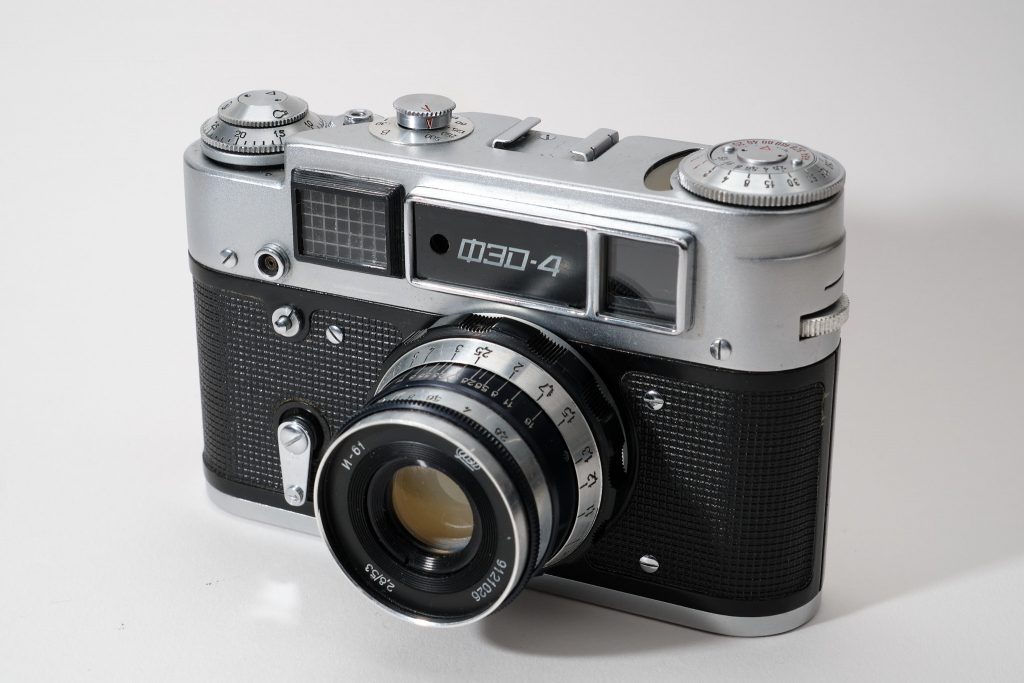
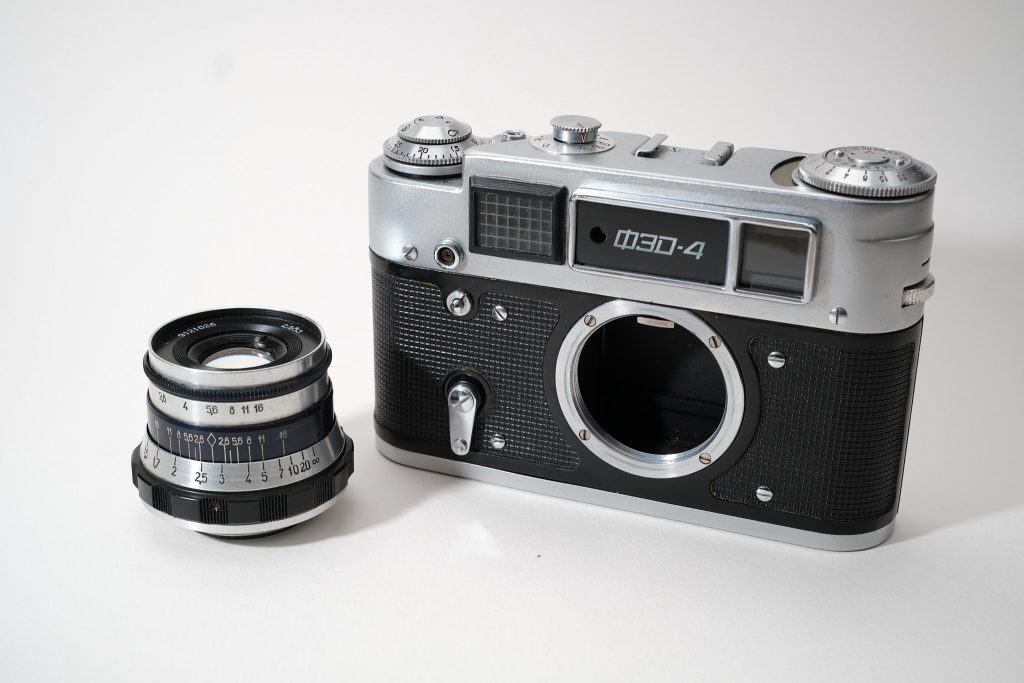
This camera is quite large and heavy compared to the compact rangefinders shown above, but with the option of interchangeable lenses it is certainly more flexible. The FED 4 has a very small viewfinder that is not easy to use with glasses, and is quite slow to operate with the separate light meter, so I would not recommend this for any kind of fast paced photography. It could be good for you if you are taking travel photos, landscapes, or similar where you can afford the time to get everything set up. Given how slow this camera is to operate and how large it is I think that in most situations an SLR camera would offer more usability without any major down sides.
- Lens: M39 mount interchangeable
- Focus: Manual with rangefinder
- Viewfinder: Separate viewfinder with rangefinder patch (small)
- Exposure: Fully manual with separate light meter
- Film speed setting: manual
- Film winding: manual
- Size and weight: Large and quite heavy. Also depends on the mounted lens
The option to change the lens of the FED 4 does open up creative possibilities, but one concern with a basic interchangeable lens rangefinder like this is that when you mount a longer or wider lens the viewfinder will not adjust to give the same view, so you need to pay careful attention to composition.
Summary of Rangefinder Cameras
The cameras shown above are from my own collection and I found all of them are quite enjoyable to use. If you are a beginner and just want more control than a point a shoot gives then an automatic rangefinder can be a great choice, and if you already understand exposure and are interested to try out vintage lenses and take a more considered approach to your photography then a more manual camera like the FED 4 can also be a lot of fun to use.
As mentioned earlier there is a long history of rangefinder cameras and so there are countless different used models are available today, ranging from the most budget friendly Soviet cameras to luxury Leica models, so there is bound to be one suitable for you.
Single Lens Reflex Cameras
When you imagine a classic 35mm film camera there is a good chance you are thinking of an SLR (single lens reflex) camera with a long lens sticking out the front. What makes an SLR special is that you compose your shot and check focus through the same lens used to take the picture. This is different to the Point and Shoot and Rangefinder cameras which all have separate viewfinders, meaning that composition cannot be as precise as an SLR. An SLR is able to achieve this view through the lens by using a mirror that flips out of the way when you take a photo.
SLRs normally have interchangeable lenses, meaning they are can be adapted for nearly any scenario from close up to wildlife photography just by swapping to a different lens. There is a huge variety of SLR cameras available on the used market today, ranging from the earliest manual models to advanced models with exposure computers and eye-controlled autofocus. I own several 35mm SLRs, including my first serious camera, the Pentax P30t from the early 1990’s. I have included a range of SLRs below to show the different levels of complexity and automation available.
Classic SLR – Canon EF
The Canon EF was introduced around 1973 and used FD mount lenses. It has a fairly basic set of features, but after shooting several rolls of film in this camera I can confirm it is perfectly usable today with just a basic understanding of exposure.
A summary of the specifications:
- Lens: Canon FD mount interchangeable
- Focus: Manual with split screen
- Viewfinder: View through the lens
- Exposure: Shutter priority or manual with built in meter
- Film speed setting: manual
- Film winding: manual
- Size and weight: Medium sized SLR, heavy due to metal construction
This camera does not feature auto-focus, however as with most manual focus SLRs it does have some built in focus aids to help with manually focusing the lens. The Canon EF features a split screen and a micro prism focus aid, making it simple to get focus spot on so long as your target is not moving! It also has some other useful features such as a self timer, double exposure button, and depth of field preview. I won’t go into all these details here, but I’m planning some camera tutorials for the future so check back later!
There are plenty of different lenses available for the Canon FD mount, however, in recent years the prices have gone up as they are easily adaptable to mirrorless digital cameras and so are more in demand.
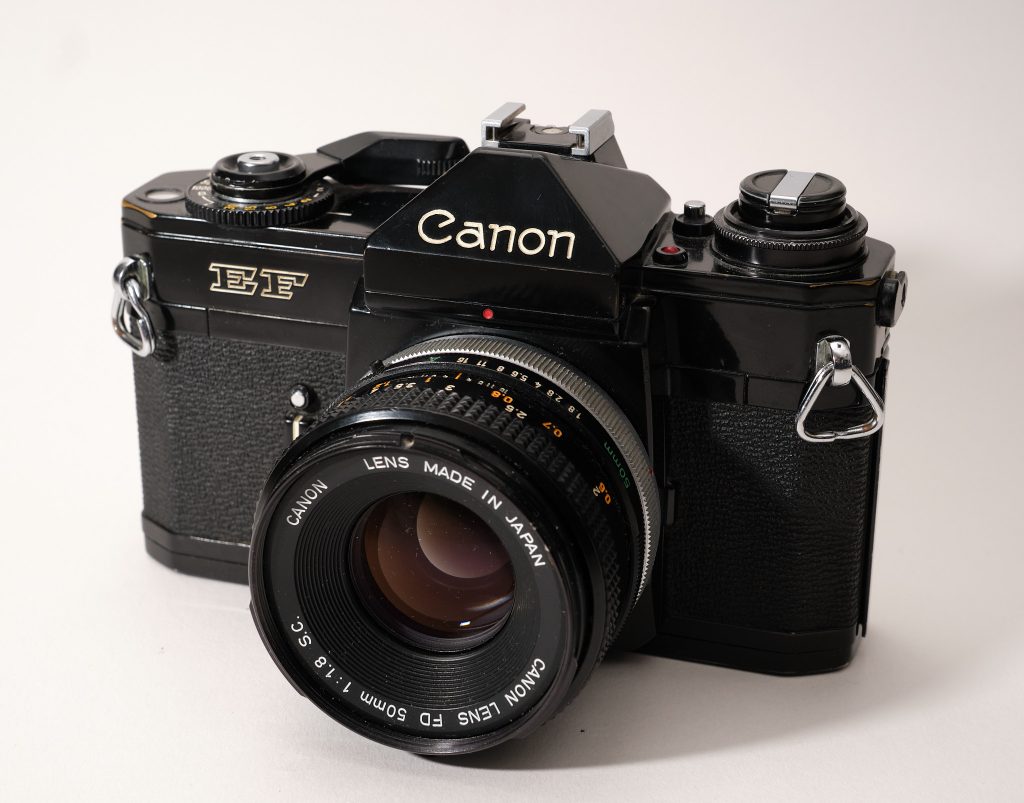
Using the Canon EF is quite straightforward, there are no mode options, just focus, adjust the shutter speed and press the shutter release.
A lot of cameras from this period are not easy to use today as they were designed for mercury batteries (no longer available), and do not work correctly with the higher voltage batteries that are available. Luckily the Canon EF includes a circuit that means modern batteries can be used without any problems.
Basic Electronic SLR – Pentax P30t
The Pentax P30t was my first ‘serious’ camera and was given to me in the early 1990’s while I was at school. A lot of the features are similar to the Canon EF in that it has manual focus, shutter priority exposure, self timer, and depth of field preview, however one major difference is that it also offers fully automatic exposure. The P30t is an electronic camera, and so nothing works without batteries. The P30t uses the Pentax KA lens mount, meaning the FD mount lenses used on the Canon EF will not fit. Pentax is renowned for the quality of their lenses and some, such as Takumar lenses, have achieved a cult status over the years. There is no shortage of Pentax lenses to choose from, and also some 3rd party lenses that use the same mount.
Manual focus on the P30t is done exactly the same way as the Canon EF, using a split screen and microprism in the viewfinder.
Summary of specs:
- Lens: Pentax KA mount interchangable
- Focus: Manual with split screen and micro prism collar
- Viewfinder: View through the lens
- Exposure: Shutter priority or manual with built in meter
- Film speed setting: DX coding only
- Film winding: manual
- Size and weight: Small sized SLR, light with partly plastic construction
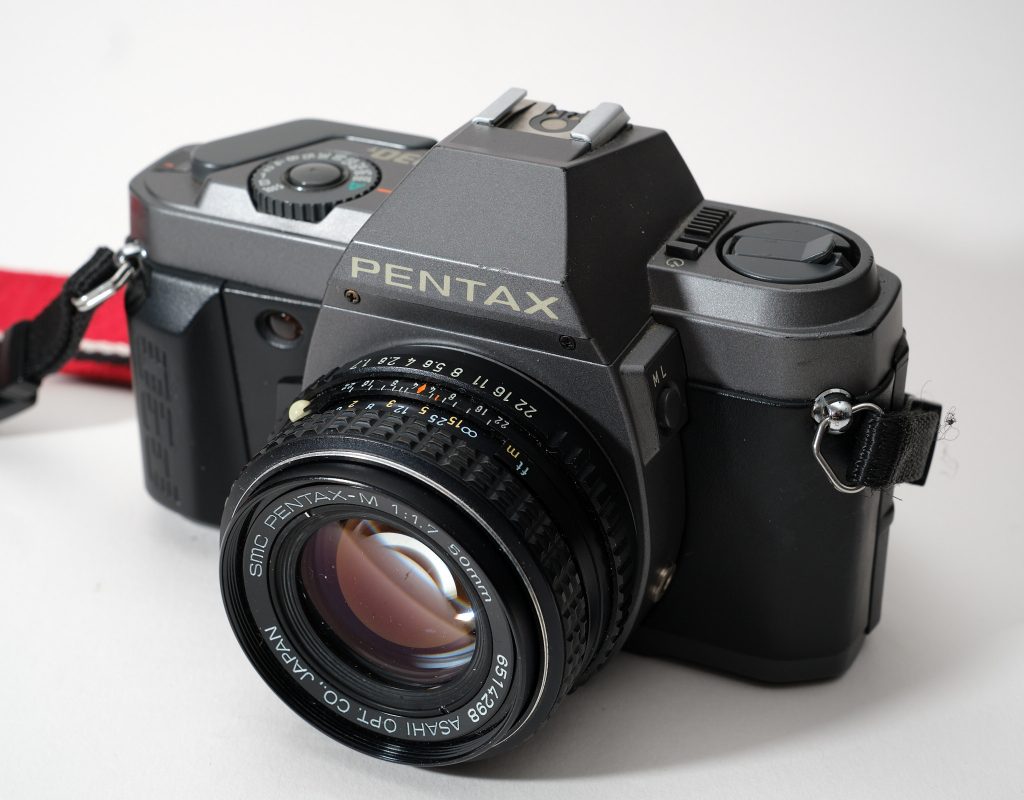
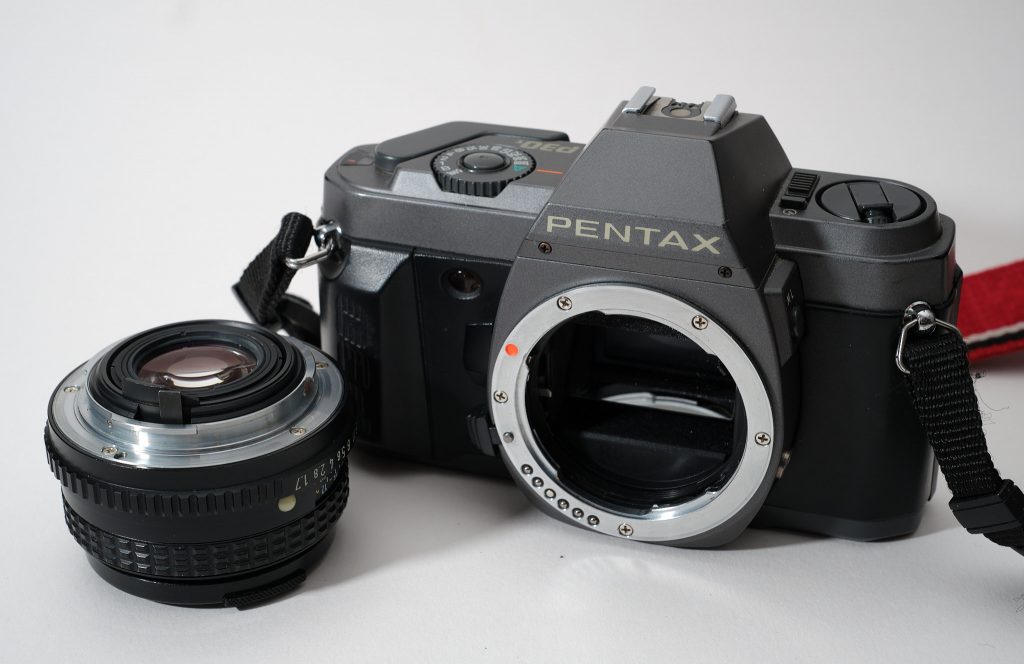
The Pentax P30t is an electronic camera, however it does lack more advanced features found on mid range and professional cameras. It makes up for this by being easy to use and giving you a way to use all the classic Pentax lenses.
Advanced Electronic SLR – Canon EOS 30
The Canon EOS 30 is an advanced SLR that was released in 2000, towards the end of the Canon film camera line up. It has many features that you would see in a DSLR or mirrorless camera today, including multiple metering modes, multipoint autofocus with object tracking, exposure compensation and bracketing, and the ability to take multiple shots per second. The Canon EOS 30 also has eye tracking autofocus, so you just need to look at the point you want to focus on and the camera will know where to focus. This is a great idea and would be useful on some of my more modern digital cameras!
The EOS 30 uses the Canon EF lens mount, so is not compatible with lenses for either the Canon FD or Pentax KA mounts on the previous two SLRs. The EF mount is used to this day for Canon DSLRs, and all EF lenses should be compatible with both film and digital SLRs so there is a huge variety of lenses available.
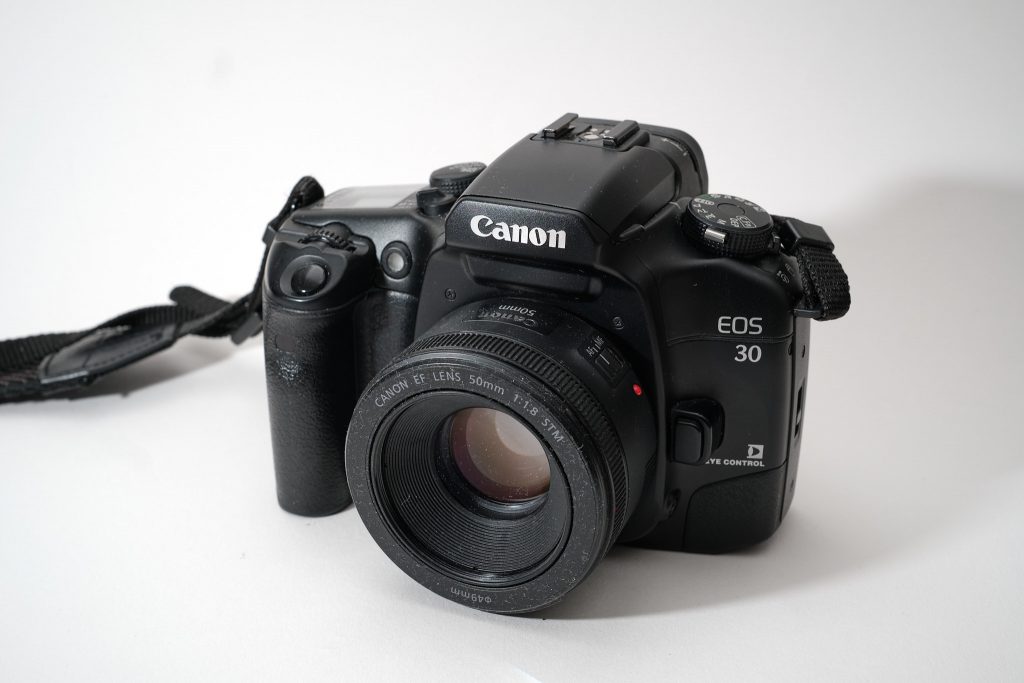
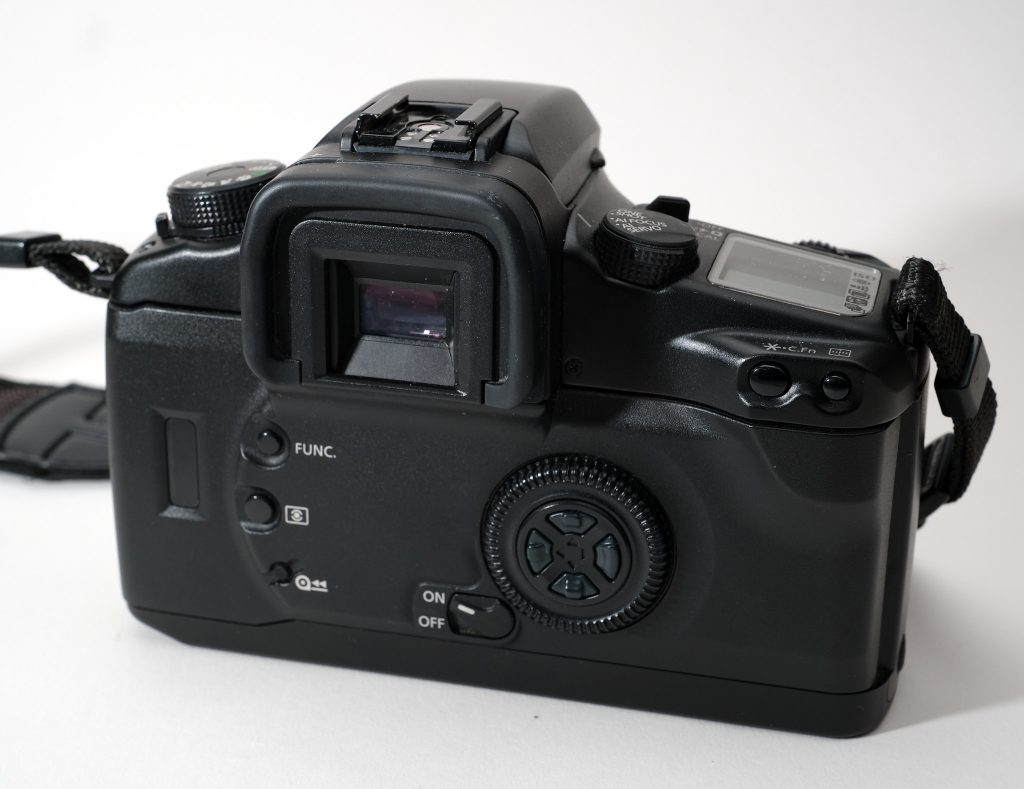
A quick look at the specs:
- Lens: Canon EF mount interchangable
- Focus: Autofocus with 7 focus points
- Viewfinder: View through the lens
- Exposure: Program (auto), aperture priority, shutter priority, manual plus other picture modes. Built in 35 zone exposure meter
- Film speed setting: DX coding or manual setting
- Film winding: automatic, 4 frames per second
- Size and weight: Full sized SLR, medium weight
The EOS 30 is quite advanced compared to all the other cameras featured here, and with the modern features and wide range of lenses available it can be used for any kind of photography. If you want a camera that you know will get the exposure right, will make sure your subject is in focus, and feels like a modern camera then this could be for you, especially when you consider the low price it is available for.
While this camera offers many technical features there are other aspects to consider, for example, the portability or the ability to blend in for street photography.
Personally I enjoy using this camera, but as it is quite large and more or less the same size as my DSLRs and mirrorless cameras it is not something I would carry with me everyday just in case, I am more likely to carry a small rangefinder with me on family outings.
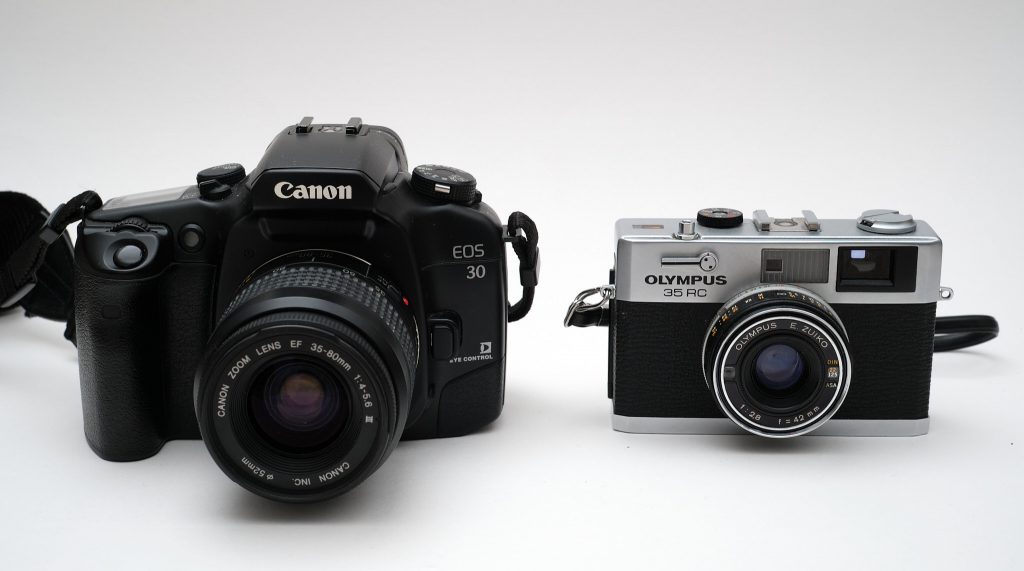
Summary of SLRs
Except for a few compact cameras that I owned before it, my photography journey started with the Pentax P30t SLR shown here. It and other manual SLRs offer everything you need to get started in photography, even if they don’t have all the advanced features found in the Canon EOS 30. Using a manual SLR does require bit of practise for focussing, but apart from that they generally get out of your way and let you focus on the subject rather than which mode you should be in. The Canon EOS 30 on the other hand is full of amazing features that are fun to play with and if I was shooting film professionally or trying to photography my children running around I am sure I would rather use this, but for me shooting film is about getting back to basics so I am more likely to pick up a manual SLR or a Rangefinder.
Wrap Up
I hope that by reading this article you have a better idea of the type of film camera you would like to get started with. A you have seen there are many different types of 35mm cameras, all with their own advantages and disadvantages, which I have tried to cover above.
There is no right or wrong choice when it comes to cameras, it all depends on what your approach to photography is and what kind of photos you want to take. For example:
- You want a camera that you can put in your pocket and take on nights out to shoot photos of your friends. The best choice here would be a compact point and shoot with a flash.
- You want to experiment with creative photography, for example, long exposures, different lenses, or shallow depth of field. In this case an SLR might be the best choice.
- You want to take candid photos on the street without being noticed, and you want control over the focus and composition. The best choice here may be a rangefinder or a compact SLR.
While it is tempting to look only at the technical features of a camera, you need to consider if you want and need a more complex camera, for many a fairly basic camera will be more than enough and will still allow you to take great shots. Also consider the size, are you more likely to carry a camera with you if you can put it in your pocket or bag? A camera sitting at home won’t get you any great photos.
Thanks for staying with me through this long article, in the next post we will look at how to load film in different cameras and how to get started shooting with film.
Have I missed any types of cameras or key points to mention? Please feel free to leave any comments below!
Links
Camera-wiki.org is a great place to find information on most film cameras before you buy.

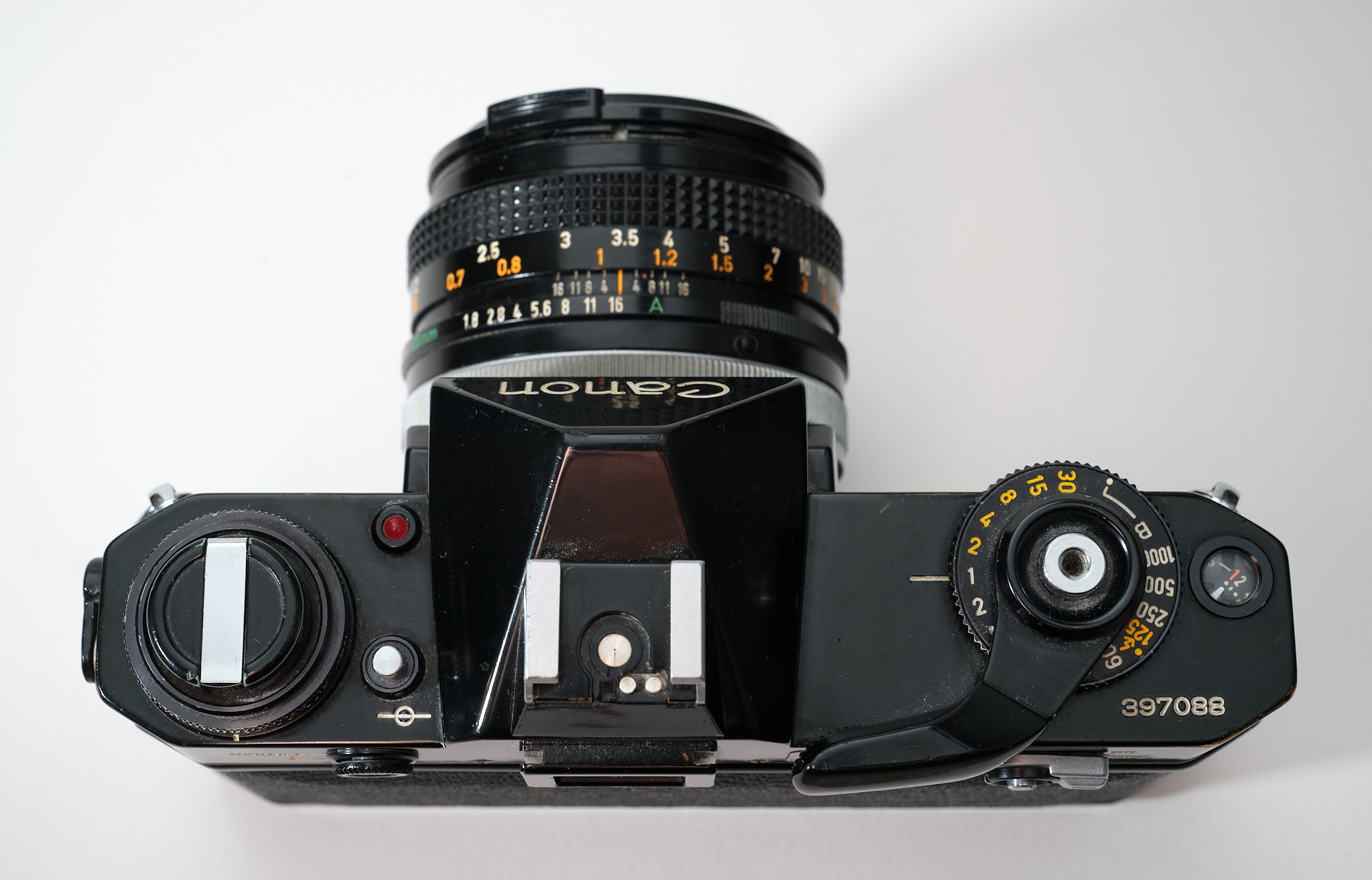
Leave a Reply